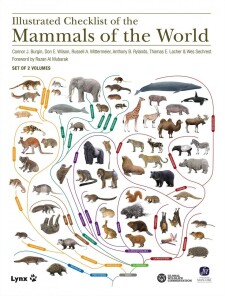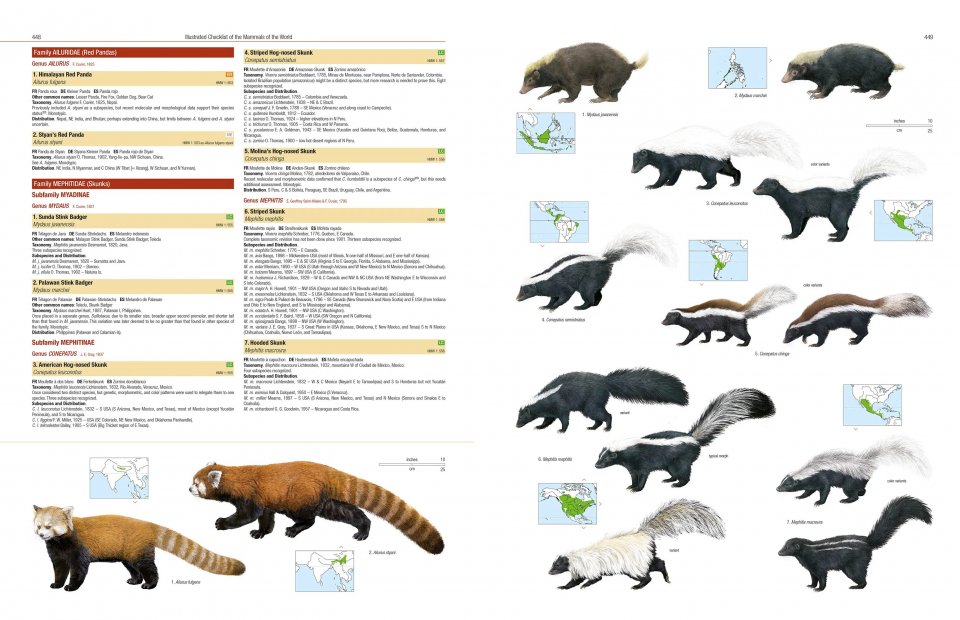Reviewed by Frank Lambert on March 16th, 2021.
Over the last decade, Lynx Edicions published a set of nine volumes in the well-received, ground-breaking Handbook of the Mammals of the World series (HMW). Published between 2009 and 2019, this is the mammalian equivalent of Handbook of the Birds of the World (HBW). Those familiar with the subsequent two-volume HBW and BirdLife International Illustrated Checklist of the Birds of the World (2014, 2016) will recognise a similar approach and style and the same high standards in this Illustrated Checklist of the Mammals of the World. Compiled by a sizeable team of experts and specialists, this is a comprehensive, two-volume boxed set in which all of the world’s mammals are illustrated alongside detailed color distribution maps. The checklist incorporates relevant data from all recently published taxonomic and distributional research, and, compared to HMW, has been completely updated at the macrosystematic, genus, species, and subspecies level for every currently recognized species of extant mammal. Indeed, if you are looking for an up-to-date list of the world’s mammals, especially an illustrated one with maps, there isn’t any alternative – this book represents a milestone for those interested in mammals. It is, however, not a field guide and for many of the smaller mammals like mice or voles, and even for some of the largest mammals, such as cetaceans, the illustrations cannot always be relied upon to identify mammals seen in the field.
The introduction to the work is brief (17 pages) but pertinent, covering topics such as ‘History of Mammalian Record-keeping’; ‘Mammalian Phylogeny and Macrosystematics’; ‘Speciation, Species Concepts, and Controversies in Mammalian Taxonomy’; ‘Morphology, Biogeography, Behavior, and Coevolution in Species Delimitation’, and ‘Speciation, and Species Concepts and Conservation Implications of Taxonomy’. There is also a short section explaining important terminology, and a three-page illustrated section on Using the Checklist, followed by almost four pages of key references. A further 845 references are provided at the end of Volume 2, where one also finds a 57-page index. For those who already own the HMW series, each species in the Checklist is cross-referenced to the volume and page where it is found in HMW.
The main part of the book is, of course, devoted to the checklist itself. The text for each species is brief, limited to information on taxonomy and distribution, and includes alternative English names for many species as well as common names in French, German, and Spanish. For polytypic species, all recognised subspecies are listed, and their distributions are summarised. The latest IUCN Red List Conservation Status is also shown. The plates, opposite the relevant text, consist of high quality illustrations alongside a colour range map for each species. For some polytypic species, such as Common Wallaroo, Black-and-White Ruffed Lemur, Blue Monkey, Maroon Langur, Brown Bear, Northern Giraffe, White-tailed Deer, Common Genet, Eurasian Red Squirrel, and Gray Wolf, distinctive subspecies are also illustrated (and for Killer Whale, various ‘types’), but for the great majority of species, there is only a single illustration, or two where sexes differ significantly. Where relevant, distribution maps have been updated from those in the HMW series.
Modern molecular research methods have transformed our ability to decipher evolutionary relationships, resulting in wide-ranging changes in the number of species recognized in almost every group of mammals. Incredibly, there has been a 54% increase in the number of recognised species of wild mammal in the last 40 years. As with birds, some of these changes involve the recognition of fascinating cryptic species, such as the tool-using Tapanuli Orangutan, restricted to a tiny area of lowland rainforest in Sumatra. Overall, there are 27 orders of mammals, and the checklist recognises 6,554 species (including 104 considered to be extinct and 19 domestic ‘species’), these belonging to 1,343 genera in 167 families. Of course, new species are still being discovered, such as Rice’s Whale (Balaenoptera ricei), a cryptic species endemic to the north-eastern regions of the Gulf of Mexico, and Popa Langur (Trachypithecus popa), endemic to central Myanmar. These were described too recently to be included in the checklist (Roos et al. 2020, Rosel et al. 2021), and whilst it is inevitable that there will be a slow trickle of newly recognised mammal species over the next decade or two, this does not in any way diminish the value of this cutting-edge publication.
Altogether, more than 7,150 illustrations are to be found in the two-volumes of this checklist along with 6,431 distribution maps. The artwork is excellent throughout, representing the work of nine artists: Toni Llobet (main artist), Ilian Velikov, Lluís Sogorb, Faansie Peacock, Alex Mascarell, Francesc Jutglar, Blanca Martí, Stephen D. Nash, and Jesús Rodríguez-Osorio. Many illustrations, including 700 of primates and more than 100 of other groups, are new or replacements of paintings featured in the HMW series. Extinct and domesticated species are not illustrated, so I was a little surprised but happy to see paintings of both sexes of Kouprey (an Indochinese bovid). In the 1990s, I organized aerial surveys in remote parts of Cambodia to look for this enigmatic species, without success, and sadly it is very likely extinct (Timmins et al. 2016): Kouprey has not been recorded since the 1960s. Who knows, it’s inclusion may foretell the rediscovery of Kouprey in a remote part of Cambodia, although this does seem exceedingly unlikely.
The species are arranged in a phylogenetic order that represents their evolutionary history, whilst the systematics lean towards a Phylogenetic Species Concept. Volume 1 covers monotremes (echidnas and Platypus) and marsupials (opposums, kangaroos), elephants (with three species now recognised), lemurs, primates, and many smaller families of placental mammal, to rodents (hares and rabbits, rats, voles, mice, squirrels). Volume 2 starts with the hedgehogs and gymnures, and includes shrews, moles, bats, whales, ungulates to pangolins, and carnivores. One thing that this book decisively demonstrates is that a significant number of the world’s mammal species are small and nocturnal. The rodents, for example, include several very large families, such as the Cricetidae (true hamsters, voles, lemmings, and New World rats and mice) with 807 recognised species and the Muridae (true mice and rats, gerbils, and relatives) with 851 species, whilst there are 454 species of shrew and an incredible 1,423 species of bat.
Two very minor things that I didn’t like so much in this book are the use of scientific names alongside the illustrations and the lack of country borders on the maps. I can understand that for non-English language speakers the use of scientific names on the plates is likely to be much more convenient, but English names would have been useful to have on the plates as well. English names for subspecies that have them are not provided, but this is probably a good thing because the use of some named populations that have become relatively well-known, such as ‘Siberian Tiger’ or ‘Bengal Tiger’ may cause misconceptions: in this case, there are currently only two recognised subspecies of this keystone predator, and both of these populations are part of nominate Panthera tigris.
I very much enjoyed looking through this book, especially the illustrations, partly because it reminded me of some of the many memorable encounters I have had with numerous species of mammal, but also because seeing all of the world’s mammals together in one publication brought home the truly remarkable number and diversity of extant species, and enabled me to “discover” numerous species that I’d never even heard of before, like the seven species of shrew moles Uropsilus spp and a plethora of little-known restricted-range species. I was also quite surprised to learn just how many splits there have been in some well-known groups, especially amongst monkeys such as the sakis, titis, and langurs: indeed, it is hard to believe that we share our planet with at least 517 species of primate. The checklist also reminds me of all the scarce and secretive mammals that I’ve sadly failed to see despite spending significant time in their habitat, such as Otter Civet, Aardvark, Mountain Tapir, Asiatic Black Bear, and African Wild Dog.
For my part, I found the beautifully produced Illustrated Checklist of the Mammals of the World to be very inspiring, and, perhaps not surprisingly, it has revitalised my interest in searching for some of the mammals that I have always wanted to see. For those with a deep interest in mammals, this book provides an unrivalled opportunity to add something very special to their library, and it is hard to envisage that they wouldn’t want to own it. For anyone who has already invested in the HMW series, the checklist provides essential updates to taxonomy, whilst maps and illustrations have been comprehensively improved in light of newly published information. Even birders with only a passing interest in mammals will likely find this book very satisfying, and although by no means a field guide, the illustrations combined with the maps can potentially help in identifying mammals one observes or photographs on any birding trip.
– Reviewed by Frank Lambert
References
Roos, C., Helgen, K.M, Miguez, R.P., Thant, N.M.L., Lwin, N., Lin, A.K., Lin, A., Yi, K.M., Soe, P., Hein, Z,M., Myint, M.N.N., Ahmed, T., Chetry, D., Urh, M., Veatch, E.G., Duncan, N., Kamminga, P., Chua, M.A.H., Yao, L., Matauschek, C., Meyer, D., Liu, Z-J., Li, M., Nadler, T., Fan, P-F., Quyet, L.K., Hofreiter, M., Zinner, D., Momberg, F. 2020. Mitogenomic phylogeny of the Asian colobine genus Trachypithecus with special focus on Trachypithecus phayrei (Blyth, 1847) and description of a new species. Zool. Res.: 41(6): 656-669. http://dx.doi.org/10.24272/j.issn.2095-8137.2020.254
Rosel, P.E., Wilcox, L.A., Yamada, T.K., Mullin, K.D. (2021). A new species of baleen whale (Balaenoptera) from the Gulf of Mexico, with a review of its geographic distribution. Marine Science. https://doi.org/10.1111/mms.12776
Timmins, R.J., Burton, J. & Hedges, S. 2016. Bos sauveli. The IUCN Red List of Threatened Species 2016: e.T2890A46363360. http://dx.doi.org/10.2305/IUCN.UK.2016-2.RLTS.T2890A46363360.en





Comment